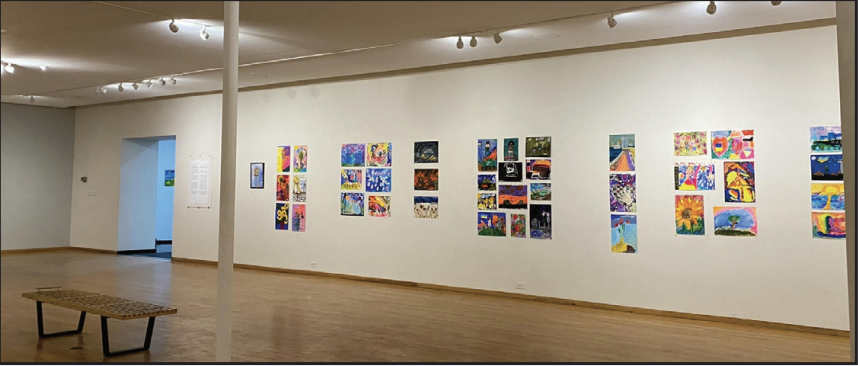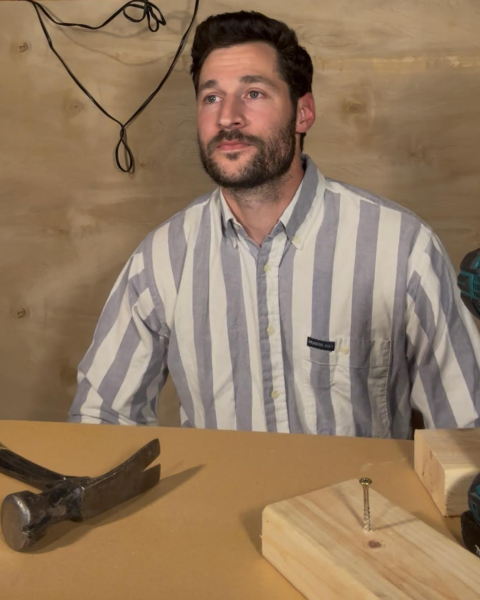Bullets, Bombs, and Barbies
Students Reflect on Art Exhibit Featuring Children’s Paintings From the Ukraine-Russia War
Photo credit: Lula Notz
The “Children of War” exhibit at the Ukrainian Institute of Modern Art in Chicago.
As you walk into the exhibit, the portraits of a stark, war-stricken country and vivid paintings of beloved pets and butterflies seem incongruous. Powerful, symbolic paintings hang beside bright flower watercolors. At the far side of the room, a TV plays interviews with the children whose art is on exhibit. The air feels stagnant, like visitors are holding their breath, and the chatter has subsided as exhibit-goers pay dutiful focus to the artwork.
One particular oil pastel drawing stood out from the other artwork in the room. It portrayed a woman with tousled sandy blonde hair and dark circles around her eyes. Her eyes make her look both distraught and exhausted. She is wrapped in a blanket and holding a baby who is calmly sleeping. She sits on dirt in front of a colorless cement building, and someone not pictured has put their hand comfortingly on her shoulder. The woman looks at the ground or into the distance as if a trance has come over her, like her body is shutting down to try to keep itself alive. It is hard to imagine that a teenager drew this, but it demonstrates the reality many children have quickly needed to adjust to.
“Children of War” was an exhibition at the Ukrainian Institute of Modern Art in Chicago. It aims to bring the reality of many in Ukraine, to the relatively unthreatened reality of the people of Chicago. From December 17 to February 12, it featured artwork by children in Ukraine who have experienced unimaginable horrors of war, trauma, and a loss of innocence, and many have developed post-traumatic stress that makes it hard for them to communicate.
“This isn’t just some random war happening halfway across the world,” freshman Daniel Chang said. “It’s very real, and it’s affecting many people.”
Starting in March 2020, Lviv artist Natalia Pavliuk and her daughter created an art therapy program. The works of children in this art therapy program are now being shown in the Ukrainian Institute of Modern Art (UIMA). Through their artwork, children displaced by war have found a way to communicate their thoughts and feelings to themselves, and now to us.
With every piece of art, the exhibit tries to spark a connection between the visitor and, as Chang said, a “very real” war, which some people are unfortunately indifferent to. It aims to spread awareness of how this war impacts the lives of people through the artwork of children. Children are usually seen as vulnerable and in need of protection. The video in the exhibit included a clip of Natalia Pavluk talking about how the children who experienced the most trauma through the war were the ones who created the colorful butterfly and flower watercolors. Children who hadn’t seen family members die in front of them were able to paint about and express the horrific events experienced during the war while children with more trauma had trouble processing it and putting it on canvas. Chang said that “the little kids liked to use bright colors and the older kids used more muted tones.”
The exhibit attempts to bring out emotion because only then, after feeling those emotions, can individuals come to the realization that this war is really happening, whether or not we feel our houses shaking, or are fleeing our homes in search of safety.
With the excess of news articles and distressing media about the Ukraine-Russia war, an art gallery is a perfect place to seek understanding and build empathy. The American Psychological Association claims that one of the key factors in the modern teenage mental health crisis is the structural factors that are affecting the world. These macro stressors such as poverty, homelessness, and climate change lead to stress-response patterns that underlie mental health challenges. War is also a macro-stressor. Some people cannot handle the stark reality of photos of buildings turned to rubble or articles presenting the number of losses after a bombing, so an art gallery can be a place to learn about major world events or issues. “Children of War” provides a place to do that.
Most of the artwork in “Children of War” explores topics such as displacement, destruction, and tragedy. Some depict tanks, some teddy bears, and others “heroic-looking Ukrainian dudes shooting down Russian missiles,” Chang said. “Oftentimes I saw paintings and drawings that looked like the kind of stuff I would draw as a little kid in my free time which made me wonder what I would feel if something like this happened to me at my age. It made me think about the futility of war.”
The more connection you feel to the artist, the more connected you are to the subject of the art. As a child, when most people’s artwork isn’t very developed, many people’s artwork made as children can share some similarities. Chang described the emotion he felt when he compared the art to his childhood artwork which may have been a thoughtful decision made by the curator to attach significance to the subject of the exhibit to each person going through it. “It [the exhibit] connects you to the fact that there are real people behind all of these stories,” Upper School history teacher Kevin Conlon, who is taking his War and Nonviolence class to the exhibit, said.
While new articles can be raw and cause many emotions, art can depict humanity. Someone across the world sat down and made the artwork that now hangs in the gallery, and the paper or canvas acts as a portal to step into their shoes. Artwork is both outspoken and true to life.
Both Chang and freshman Chloe Deutsch recalled the same piece of artwork as being the most full of sadness and feeling and that acted most like a gateway to the child’s experience. “On the second wall, there was a drawing of a little girl hugging her dad goodbye while he is dressed in army clothes, and she is holding a teddy bear,” Deutsch said. She added that it “looked very heartfelt and sad and it made me think about how the war has broken families apart. The thought of how many kids must have gone through this with their fathers is scary.”
This work was the centerpiece of the room, but surrounding it were pieces with Ukrainian flags, sunflowers, and fields of wheat, all of which are major Ukrainian symbols. One painting depicted houses wrapped in bubbles of water floating away, another of a home on fire with kids’ toys thrown out on the lawn. Some depicted violence, with tanks, guns, and fire. Others portrayed flower vases, stick figures, and lost or abandoned pets. One looked strikingly like a Van Gogh, and quite a few had Picasso-like qualities of exploring structure and form whether intentional or accidental.
Both Chang and Deutsch also took notice of the fact that this exhibit was unlike any they had been to before. “I’ve been to an art exhibit of Picasso’s work in France and an ancient Japanese manga exhibit, but in this one, I felt more connected to the subjects with this one because it is ongoing right now, whereas Picasso’s dead, and the invention of manga happened like 400 years ago,” Chang said. Deutsch noticed the unique size of the exhibit as different from many others around Chicago which fosters an intimacy between the people walking through the exhibit together.
Parker students are taught to be global citizens, aware of the wider world, as well as their place in it. “Parker in theory has an emphasis on internationality. We invite guest speakers from across the nation and always host an exchange student. I think that’s a good mindset to have and I feel like going to this exhibit can increase that internationality,” Chang said. He feels that on top of everything Parker does to educate us on the wider world outside of our Parker bubble, visiting places like this exhibit can increase that invaluable knowledge.
As a city, it is important to recognize the struggles of people around the world. “We have this great resource in our city in this place to show solidarity with Ukrainians in Chicago and in Ukraine. It’s an exercise in empathy,” Conlon said. The only problem is that many people feel so far away from trouble happening overseas that they are unconcerned. “I think the exhibit helps to convey the feelings of Ukrainians to us, to people who are relatively comfortable in a relatively safe city. It conveys those feelings, shows what they are going through, and brings attention to it because unfortunately there are still people who are indifferent to the war, but if they were to see this exhibit I feel like their opinions would change.”













